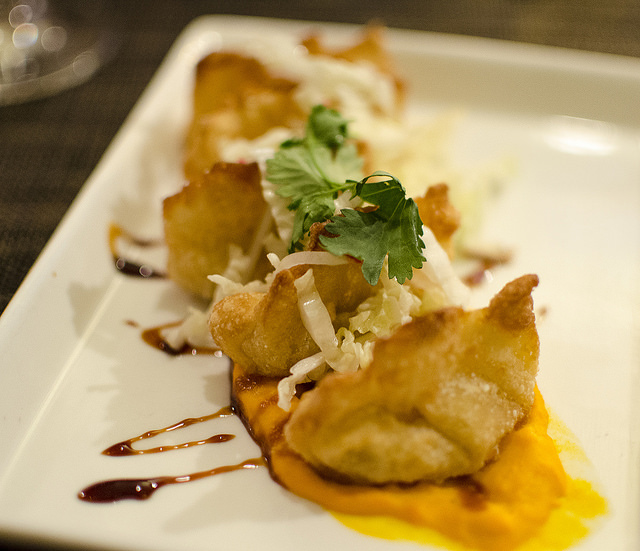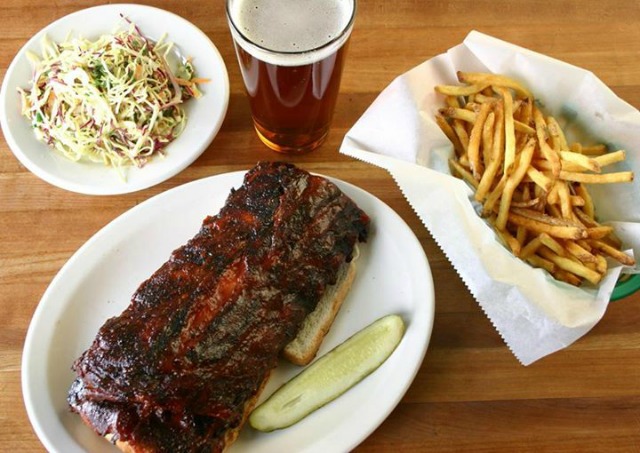Your Guide To The Best (And Absolute Worst) Restaurant Week Deals
By Anthony Todd in Food on Jan 13, 2016 4:17PM

A dish at Intro, one of our recommended choices for Restaurant Week. Photo by Anjali Pinto.
Restaurant Week. Most people think it’s a time for deals, a great opportunity to try out new restaurants all over the city at bargain prices. Reservations for choice restaurants book completely solid weeks in advance, and even spots that normally wouldn’t be on diners’ radar get a bump in attendance. The event is now in its ninth year, and grows bigger every time. But is it actually a good deal for diners, or are you (maybe) getting screwed?
Here are the basics of Restaurant Week: Restaurants create a prix fixe menu for lunch ($22) or dinner ($33 or $44, at the restaurant’s discretion). This menu is published online for a few weeks before Restaurant Week begins, so diners can choose their favorites and make reservations. If you're looking for some quick tips, we've got you covered.
We also have some updates to this massive list, with responses from some of the restaurants which were less than thrilled with our assessments.
The Problem With Restaurant Week
I’ve suspected for a while that Restaurant Week might not actually be a very good deal. But how could I prove it? How could one figure out the value that a diner was actually getting for their money? The answer, it turns out, is to do a lot (a LOT) of math. We crunched the numbers—all of the numbers—so you can enjoy your deals without worrying about getting ripped off.
Most restaurants, when creating Restaurant Week menus, pull dishes (or slight variations of dishes) off of their normal menus. That means that it is possible to compare exactly what a diner would have paid for the same meal if they had gone as a normal diner. If a Restaurant Week menu offers a garden salad, a burger and a slice of pie for $33, you can go onto the restaurant’s website and add up the price of that same salad, burger and slice of pie. Does it add up to more than $33? You’re potentially getting a good deal. Does it add up to less than $33? You’re actually paying a premium for bigger crowds and fewer choices.
To make things even more complicated, some restaurants offer choices, and the choices usually aren’t the same price. So, you might get a good deal if you order the right thing, but if you pick badly, you’re losing money.
“But,” you might say, “no restaurant actually does that, right? Why would they be so absurd/mean/crafty as to take advantage of diners?” Turns out, intentional or not, it happens way more often then you’d think.

"Acorn Squash Potstickers, soy caramel, carrot sesame purée, shaved radish" at Green Zebra (Photo by Stephanie/Creative Commons)
Our Methodology
I did the math behind every single Restaurant Week menu to figure out which were great deals and which were total dogs. The results are in the spreadsheet below. It's the ultimate guide to not getting screwed during Restaurant Week 2016. In addition to all this math, I distilled down my top 10 tips for getting a bargain during restaurant week, which will be coming in a separate post later this afternoon.
My primary goal was to figure out if it was possible to create a meal that was a “bad deal;” that is, if you ordered the same dishes from the regular menu, you’d spend less than the Restaurant Week prix fixe price. The restaurants highlighted in red, below, are the ones for which I found a combination of dishes that would cause the diner to lose money.
A few caveats. First, I necessarily had to do a lot of approximating. Sometimes, dishes were close, but not exactly, what was on menus, and I had to guess. Sometimes, since I was doing math until my eyes glazed over, I could have made a mistake. And sometimes the restaurant’s online menu is out of date or inaccurate. Always check first before you take my word for it. I only evaluated dinner menus, both because to do everything would have killed me and because lunch is almost always a good deal during restaurant week. I also didn’t do multiple locations of chains.
The Findings
I uncovered some pretty bad deals. Take, for example, Smoke Daddy in Wicker Park. Their Restaurant Week dinner costs $44, and you get three courses. The most expensive appetizer you can pick is Smoked BBQ Wings ($8), and the most expensive main is the Taste of the Daddy ($25). There’s no choice for dessert—it’s banana pudding for $6. Do the math: that adds up to $39. You can’t possibly break even.
Most places aren’t like that—you can break even if you try. But the number of spots where you are guaranteed a deal, no matter what you order, is not that large.
If the restaurant is highlighted in green, it is one of my recommended picks. These restaurants have a combination of a good deal, a menu with a fair amount of variety and food quality that I’d feel comfortable recommending. Usually, it means that no matter what you order, you’ll get a bargain.
The Bottom Line
Remember, folks, you don’t have to go to a restaurant during Restaurant Week—there are 50 other weeks of the year when crowds will be lower, and you’ll get the full variety of a regular menu. In fact, if you’re not getting a great deal during Restaurant Week, you’re probably getting screwed even if you technically manage to break even. You’re not getting the full experience of the restaurant, so unless you’re making bank (or the Restaurant Week menu is really special), what’s the point?
And just because a restaurant is highlighted in red doesn’t mean 1) it’s a bad restaurant; 2) the owners are trying to screw you or 3) I wouldn’t go there! All it means is that it is possible to get a bad deal there during Restaurant Week. Often, I love these restaurants, and would wholeheartedly recommend that you go during the rest of the year, and sometimes, you should go to them anyway even during Restaurant Week. Just beware.
Finally, before people write in to complain, I know that restaurants often shrink their portion sizes during Restaurant Week. I couldn’t account for that, but here’s what that means: If you’re barely breaking even on the price, then you’re probably actually losing money.
All the disclaimers aside, here is the full list—your best bet at getting a restaurant week value. Browse the spreadsheet below or view it in a new tab.
The Key
If a restaurant is highlighted in red, that means that I found a clearly bad deal—and you'll lose money on that combination.
If a restaurant is highlighted in green, that means it's very difficult to get a bad deal and I think the restaurant is good, unique, or delicious enough to be a strong Restaurant Week pick.
